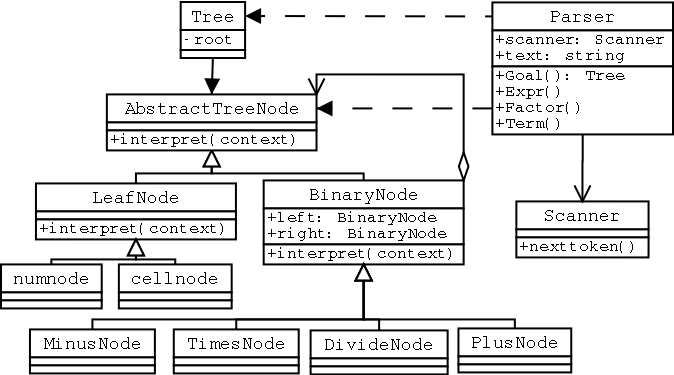Interpreter Pattern
Starting Point Analysis
In the observer pattern, we only considered assign a numeric value to a cell. In our project requirment, the cell value could be numeric or arithmatic expression that consists of number(s) and/or reference(s) to other cells. For these kinds of expression, we have to store it in the Data object so that when values of the referenced cells are changed, the referencing cell's value also can be automatically updated. There are at least two options store the express. One option is storing the expression as a string, which is assigned to a cell by user. If the expression contains a cell reference, we replace them by value of the referenced cell value. Then using the built-in function of python eval() to evaluate the string. The another option is parsing the expression as a binary tree structure. The first option has to replace the cell reference each time when a cell's value is changed before calling eval(). And more, we have to checking the lexical and syntax of a usr-typed expression string. So I prefer to use the second option.
Requirement in this phase
In this phase, I only need to build a parser which can parse a arithmatic expression into a binary tree and can evaluate this tree given the referenced cells' value. We do not consider how it related to the project. I suppose any cell reference is in the form of '$i$j', where i is a cell's row positon, j is a cell's col position.
The arithmatic expression grammer
Our parse should recognize the following grammer:
goal -> expr&END
expr -> factor&expr-tail
expr-tail ->^
expr-tail -> '+' & expr
expr-tail -> '-' & expr
factor -> term & factor-tail
factor-tail ->^
factor-tail ->'*'&factor
factor-tail ->'/'&factor
term -> number
term -> $i$j
term -> '(' & expr &')'
tokens: (, ), num, $i$j, +, -, *, /, END
Interpreter Pattern Overview
The following simple description of interpreter pattern is from the book, Design Patterns. Please see page 243-255 of this book for more details.
Intent
Given a language, define a represention for its grammar along with an interpreter that uses the representation to interpret sentences in the language.
Structure

participants
- AbstractExpression (RegularExpression)
- declares an abstract Interpret operation that is common to
all nodes in the abstract syntax tree.
- TerminalExpression (LiteralExpression)
- implements an Interpret operation associated with terminal
symbols in the grammar.
- an instance is required for every terminal symbol in a
sentence.
- NonterminalExpression (AlternationExpression,
RepetitionExpression, SequenceExpressions)
- one such class is required for every rule R ::=
R1 R2 ... Rn
in the grammar.
- maintains instance variables of type AbstractExpression
for each of the symbols R1 through
Rn.
- implements an Interpret operation for
nonterminal symbols in the grammar. Interpret typically calls itself
recursively on the variables representing R1 through
Rn.
- Context
- contains information that's global to the interpreter.
- Client
- builds (or is given) an abstract syntax tree representing a
particular sentence in the language that the grammar defines. The
abstract syntax tree is assembled from instances of the
NonterminalExpression and TerminalExpression classes.
- invokes the Interpret operation.
UML Design in this phase
Our arithmatic expression is also a language. So the interprter pattern is quite suitable for this phase. Based on this pattern, I design the following UML class diagram.

Steps in this phase
- step 1: implement the tree classes.
Test the class in the python interactive interface, the running result could be like this.
- step 2: implement the scanner and parser classes.
We simply test the source code in the python interactive interface, the runing result could be like this.
References
Erich Gamma, Richard Helm, Ralph Johnson and John Vlissides Design Patterns Elements of Reusable Object-Oriented Software Addison-Wesley, 1995


